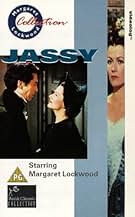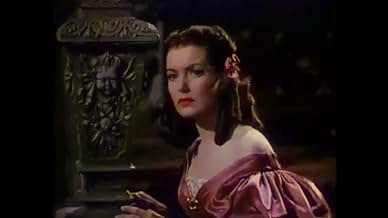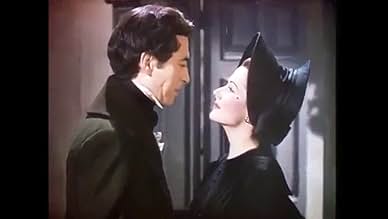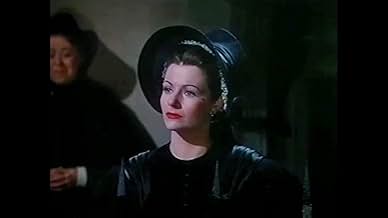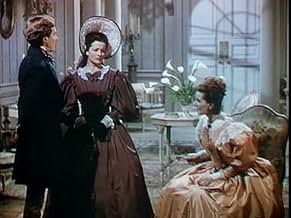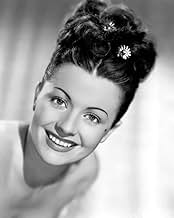Jassy, a 17th-century English girl with prophetic visions, is accused of witchcraft. Barney Hatton, whose father gambled away their home, aids her. Grateful, Jassy vows to help Barney reclai... Read allJassy, a 17th-century English girl with prophetic visions, is accused of witchcraft. Barney Hatton, whose father gambled away their home, aids her. Grateful, Jassy vows to help Barney reclaim his property, regardless of the consequences.Jassy, a 17th-century English girl with prophetic visions, is accused of witchcraft. Barney Hatton, whose father gambled away their home, aids her. Grateful, Jassy vows to help Barney reclaim his property, regardless of the consequences.
- Awards
- 1 nomination total
Featured reviews
Muriel Box grumbled to her diary when Gainsborough's first film in Technicolor hit screens "Bad notices, bad film - huge commercial success".
A barnstorming gothic melodrama set in 1830 with glowing Technicolor photography by Geoffrey Unsworth sweeping about Maurice Carter's sets, it enabled audiences suffering the daily realities of life in postwar austerity Britain to wallow in the vicissitudes of an era even harsher than their own while savouring the brightly coloured frocks devised by Elizabeth Haffenden for Margaret Lockwood & Patricia Roc.
It is also awash with familiar faces, although they are seldom onscreen for very long; notable exceptions being Basil Sydney as the riding crop-wielding meanie Jassy marries for the house he won off Denis Price playing cards; and Esma Cannon in one of her early dramatic roles as 'the loony'. (Price murdered Miss Cannon in the same year's 'Holiday Camp, but here they share no scenes).
Great fun.
A barnstorming gothic melodrama set in 1830 with glowing Technicolor photography by Geoffrey Unsworth sweeping about Maurice Carter's sets, it enabled audiences suffering the daily realities of life in postwar austerity Britain to wallow in the vicissitudes of an era even harsher than their own while savouring the brightly coloured frocks devised by Elizabeth Haffenden for Margaret Lockwood & Patricia Roc.
It is also awash with familiar faces, although they are seldom onscreen for very long; notable exceptions being Basil Sydney as the riding crop-wielding meanie Jassy marries for the house he won off Denis Price playing cards; and Esma Cannon in one of her early dramatic roles as 'the loony'. (Price murdered Miss Cannon in the same year's 'Holiday Camp, but here they share no scenes).
Great fun.
Set in the 1830s, in elegant period costume, JASSY is a very English tale of love, hate, marriage, adultery, sadistic husbands, scheming wives, whip-wielding fathers, capricious lovers, unrequited love, gambling addicts, snobbery, class antagonism, bigotry, a girls' boarding school, country houses and masters and servants. Oh, and two murders, one by poisoning. And a suicide. It would be nice to add: - and all in the first reel. Well, not quite.
Bernard Knowles, a distinguished cameraman turned moderate director, makes something of a jumble of the first half hour, introducing too many characters and failing to distinguish those with an important part to play. It seems at first, for example, that the splendid Linden Travers as Lady Helmar will be a major protagonist, but she disappears after a couple of scenes, a typical waste of her talents. It's only with Barney's rescue of Jassy that Knowles starts to pull the disparate threads together.
Margaret Lockwood is wonderful as Jassy, the remarkable, psychic, gypsy girl with immaculate English enunciation, though brought up and tutored solely by her father, the resolutely Scottish John Laurie. Coping well enough as the disadvantaged young woman working at the finishing school, she really gets into her stride as the whip-cracking - metaphorically speaking - mistress of the manor house. Looking, as she does, the epitome of glamour, it's no wonder lecherous landowner Helmar - Basil Sydney - finds it difficult to keep his hands off her. Strutting around like an overfed turkey-cock he's entertaining throughout; both he and Lockwood kept getting the giggles in their highly-charged scenes together, setting each other off, causing several re-takes. No doubt some of the corny dialogue didn't help and later, in the court-room scene, Alan Wheatley uses the old acting technique of speaking very slowly and deliberately, to take the curse off a particularly trite sentence. Matching Margaret in the glamour stakes, Patricia Roc 'The Goddess of the Odeons' is excellent as the fickle, opportunistic Dilys, a welcome contrast to her goody-goody Caroline in THE WICKED LADY. The young Dermot Walsh is convincing as one of the few wholly honest characters. All this and Dennis Price, Esma Cannon, then around fifty but playing the much younger Lindy and Ernest Thesiger too.
Thought lost for many years, JASSY was located and restored in the early 1980s, receiving its first British TV transmission in December 1984 on Channel Four. I should love the opportunity to see Jassy and Dilys on the big screen and the continuing lack of a DVD release remains a mystery. Certainly for Margaret Lockwood fans, JASSY is a film to see again. And again...
Bernard Knowles, a distinguished cameraman turned moderate director, makes something of a jumble of the first half hour, introducing too many characters and failing to distinguish those with an important part to play. It seems at first, for example, that the splendid Linden Travers as Lady Helmar will be a major protagonist, but she disappears after a couple of scenes, a typical waste of her talents. It's only with Barney's rescue of Jassy that Knowles starts to pull the disparate threads together.
Margaret Lockwood is wonderful as Jassy, the remarkable, psychic, gypsy girl with immaculate English enunciation, though brought up and tutored solely by her father, the resolutely Scottish John Laurie. Coping well enough as the disadvantaged young woman working at the finishing school, she really gets into her stride as the whip-cracking - metaphorically speaking - mistress of the manor house. Looking, as she does, the epitome of glamour, it's no wonder lecherous landowner Helmar - Basil Sydney - finds it difficult to keep his hands off her. Strutting around like an overfed turkey-cock he's entertaining throughout; both he and Lockwood kept getting the giggles in their highly-charged scenes together, setting each other off, causing several re-takes. No doubt some of the corny dialogue didn't help and later, in the court-room scene, Alan Wheatley uses the old acting technique of speaking very slowly and deliberately, to take the curse off a particularly trite sentence. Matching Margaret in the glamour stakes, Patricia Roc 'The Goddess of the Odeons' is excellent as the fickle, opportunistic Dilys, a welcome contrast to her goody-goody Caroline in THE WICKED LADY. The young Dermot Walsh is convincing as one of the few wholly honest characters. All this and Dennis Price, Esma Cannon, then around fifty but playing the much younger Lindy and Ernest Thesiger too.
Thought lost for many years, JASSY was located and restored in the early 1980s, receiving its first British TV transmission in December 1984 on Channel Four. I should love the opportunity to see Jassy and Dilys on the big screen and the continuing lack of a DVD release remains a mystery. Certainly for Margaret Lockwood fans, JASSY is a film to see again. And again...
A busy, almost overwrought period melodrama from Gainsborough that's so plot-heavy no scene seems to last longer than 30 seconds. The studio clearly lavished plenty of money on the production, and the stars give it their all to make Jassy an enjoyable, if slightly silly, watch.
This proclaims itself as a tale of the 17th century, yet costumes, sets and props belong to the late 18th early 19th as understood in the 1940s. The manners, speech and relationships are early 20th century. The fact that this imposes on the audience describes just how "exciting" this tale is. Unfortunately, the attitude to superstition and witchcraft belongs to an earlier time. The fantasy about how servants were treated is completely laughable. Some careers clearly in a rut. Even the presence of Esma Cannon cannot rescue this tripe.
Margaret Lockwood is good in this sinister tale of 17th Century British mysticism. She is the eponymous character who can sense impending doom. A dangerous occupation back then, but luckily (or not) local landowner "Barney Hatton" (Dermot Walsh) sees a way of using her to help restore his family fortunes lost by his father (Dennis Price) at the hands of the pretty odious "Helmer" (Basil Sydney). As the plot unravels, we discover that "Jassy" has her own particular axe to grind too - and, well let's just say you wouldn't want to be "Helmer"! The look of the film has something of the Daphne du Maurier about it, but the plot is a little too slow to develop, and there is much too much dialogue. Still, Lockwood is well worth watching here - as usual - and there is just enough menace provided by the eerily lit and well scored production to keep this interesting.
Did you know
- TriviaThe first Gainsborough Pictures film to be shot in Technicolor.
- GoofsAlthough set in the 19th century, 18 minutes into the film, an automobile can be seen through the window.
- ConnectionsReferenced in When the Bough Breaks (1947)
- How long is Jassy?Powered by Alexa
Details
- Runtime1 hour 40 minutes
- Aspect ratio
- 1.37 : 1
Contribute to this page
Suggest an edit or add missing content


